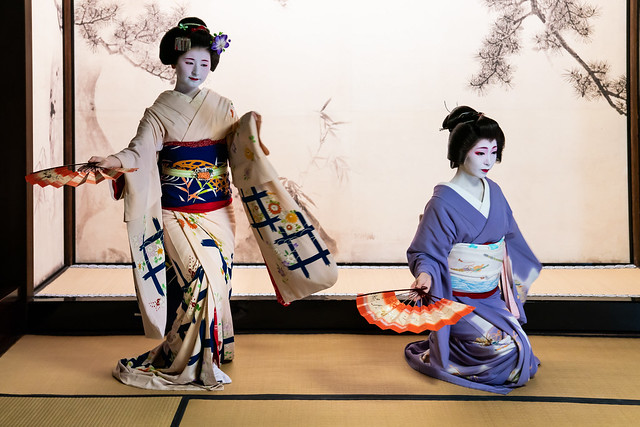
Japanese geisha culture has long transfixed people around the globe, with its ornately patterned kimonos, striking makeup and refined code of etiquette.
To many in the west, it encapsulates the stereotype of an ancient and exotic japan, a vestigial tradition unlike anything else in the modern world. But in reality, the history of the geisha is far more recent and often less exotic than one might expect.
The term ‘maiko’ is a part of that history. And with the word entering the western cultural consciousness with the critically acclaimed Netflix series The Makanai: Cooking for the Maiko House, we thought we’d demystify the geisha tradition, and provide some insight into how it works in the modern world.
What is a Maiko?
In short, a maiko (舞妓 – may-ko) is an apprentice geisha. A direct translation would be ‘dancing child’, reflecting the youth of such apprentices, and one of the skills they are expected to learn.
Maiko may join an okiya, the lodging house where geishas train and perform, at as early as 14-15 years old – historically this was even younger. Certain government restrictions encourage conventional schooling up until a point, as such Maiko typically debut around 17-18. The complete period of training from maiko to geisha takes around 6 years.
What is a geisha?
Geisha can be translated as ‘art-person’, or simply ‘artist’. Outside of the English connotations of that term, it more aptly refers to a female hostess who entertains guests with performances and conversation.
In Kyoto, the historic capital of Japan from which geishas emerged, such entertainers are called ‘geiko’, meaning ‘woman of art’. But it’s the Tokyo variant of this term that has entered the popular consciousness, perhaps because of the greater number of international visitors to that sprawling metropolis.
The nature of their work, female hostesses catering primarily to male clients, has led to assumptions that geishas are prostitutes, though this is not the case. Many early geishas were former prostitutes who had worked in the pleasure quarters of Japanese cities (walled in red-light districts where sex work was legal), but the profession itself has roots in the chaste entertainers who also performed there. As the services of geishas surged in popularity, authorities made it clear that sexual relationships with their clients were forbidden, though they would sometimes occur.
Despite their timeless garments and association with traditional Japan, female geishas only emerged in the 18th century, a relatively recent development in the country’s millennia long history.
Their numbers have dropped significantly since the post war period, as the popularity of bar hostesses and karaoke have overshadowed their profession.
Differences between Maiko and Geisha
Maiko can be identified by their difference in style of dress, such as a red collar and distinct shoes, and their makeup.
One notable trait is the single red bottom lip, contrasted with the brilliant white makeup of the rest of the face. The latter feature was originally employed to make their appearance stand out in rooms lit only by candlelight.
What does Makanai refer to?
Makanai, as referred to in the title of Cooking for the Maiko House, is a term that has more to do with cooking than with the maiko. It refers to the kind of meals that are prepared for employees rather than guests. In the show, the protagonist cooks such meals for the other trainee geisha. Read this article for more information on makanai.